LITE ON TECHNOLOGY LE500 Monitor User Manual 06485
Lite-on Technology Corp. Monitor 06485
users manual
i
Contents
1 Using Your LE500 Monitor . . . . . . . . . . . . . . . . . . . . . . . . . . . . . . . . . . . . . . . 1
Safety precautions . . . . . . . . . . . . . . . . . . . . . . . . . . . . . . . . . . . . . . . . . . . . . . . . . . . 2
Setting up the monitor . . . . . . . . . . . . . . . . . . . . . . . . . . . . . . . . . . . . . . . . . . . . . . . . 3
Removing the base . . . . . . . . . . . . . . . . . . . . . . . . . . . . . . . . . . . . . . . . . . . . . . . 5
Starting the monitor . . . . . . . . . . . . . . . . . . . . . . . . . . . . . . . . . . . . . . . . . . . . . . . . . . 6
Adjusting display settings . . . . . . . . . . . . . . . . . . . . . . . . . . . . . . . . . . . . . . . . . . . . . 7
OSD options . . . . . . . . . . . . . . . . . . . . . . . . . . . . . . . . . . . . . . . . . . . . . . . . . . . . 8
Video modes . . . . . . . . . . . . . . . . . . . . . . . . . . . . . . . . . . . . . . . . . . . . . . . . . . . 10
Power management . . . . . . . . . . . . . . . . . . . . . . . . . . . . . . . . . . . . . . . . . . . . . . . . 11
ENERGY STAR . . . . . . . . . . . . . . . . . . . . . . . . . . . . . . . . . . . . . . . . . . . . . . . . 11
Energy declaration . . . . . . . . . . . . . . . . . . . . . . . . . . . . . . . . . . . . . . . . . . . . . . 11
Maintenance . . . . . . . . . . . . . . . . . . . . . . . . . . . . . . . . . . . . . . . . . . . . . . . . . . . . . . 12
Troubleshooting . . . . . . . . . . . . . . . . . . . . . . . . . . . . . . . . . . . . . . . . . . . . . . . . . . . . 13
No picture . . . . . . . . . . . . . . . . . . . . . . . . . . . . . . . . . . . . . . . . . . . . . . . . . . . . . 13
Picture is scrambled . . . . . . . . . . . . . . . . . . . . . . . . . . . . . . . . . . . . . . . . . . . . . 14
Display colors are wrong . . . . . . . . . . . . . . . . . . . . . . . . . . . . . . . . . . . . . . . . . 14
Picture is fuzzy . . . . . . . . . . . . . . . . . . . . . . . . . . . . . . . . . . . . . . . . . . . . . . . . . 15
Picture bounces, jitters, or has waves . . . . . . . . . . . . . . . . . . . . . . . . . . . . . . . 15
Picture has shadows or “ghosts” . . . . . . . . . . . . . . . . . . . . . . . . . . . . . . . . . . . 15
Color is not uniform . . . . . . . . . . . . . . . . . . . . . . . . . . . . . . . . . . . . . . . . . . . . . 16
Image is not sized or centered properly . . . . . . . . . . . . . . . . . . . . . . . . . . . . . . 16
Image cannot be adjusted full screen . . . . . . . . . . . . . . . . . . . . . . . . . . . . . . . 16
Specifications . . . . . . . . . . . . . . . . . . . . . . . . . . . . . . . . . . . . . . . . . . . . . . . . . . . . . . 17
2 Safety, Regulatory, and Legal Information . . . . . . . . . . . . . . . . . . . . . . 19
ii

1
1
Using Your
LE500 Monitor
This monitor provides high resolution performance and operates in a variety of video
modes. The flat square tube design makes images easier to see.
The Microprocessor-based On-Screen Display (OSD) controls let you adjust a variety of
image settings.
2 Using Your LE500 Monitor
Safety precautions
nRead all instructions before using the monitor, and save them for later use.
nFollow all warnings and instructions marked on the product.
nTo avoid electrical shock, never open the monitor case.
nNever use the monitor if the power cable has been damaged. Do not allow anything
to rest on the power cable.
nThe openings in the monitor cabinet are for ventilation. Do not block or cover these
openings. Do not insert anything into these openings. If you put the monitor in a
bookcase or some other enclosed space, be sure to leave space for ventilation.
nDo not expose the monitor to rain or use near water. Turning on a monitor that has
been exposed to moisture will cause damage. If the monitor gets wet, unplug it, and
contact technical support.
nThis monitor is equipped with a 3-wire grounding-type plug as a safety feature. This
plug will only fit into a grounding-type outlet. If you are unable to insert the plug
into an outlet, contact an electrician to install the appropriate outlet. Do not try to
remove any of the prongs.
nIf any problems occur, unplug the monitor and contact technical support.
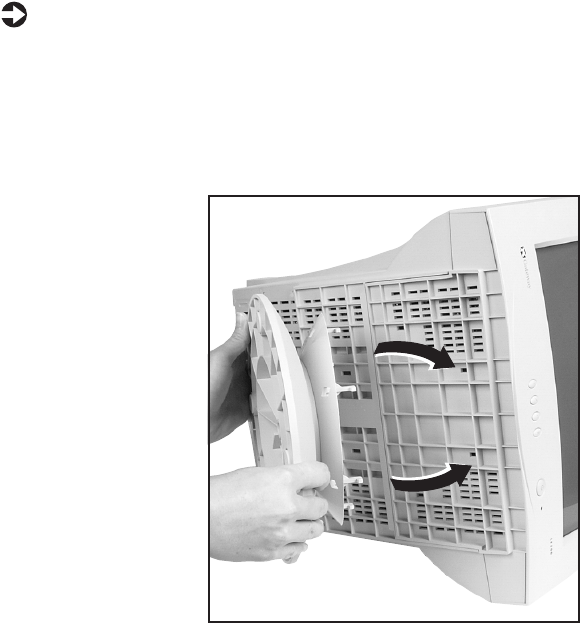
Setting up the monitor 3
Setting up the monitor
Setting up the monitor consists of two procedures: attaching the base and connecting the
monitor cables.
If you are setting up your system for the first time, refer to the setup poster for more
information about connecting additional peripherals.
To attach the base:
1Carefully set the monitor on its side with the bottom of the monitor facing you.
2Hold the base so that the narrow end is pointed toward the back of the monitor.
3Align the four hooks on the bottom of the base with the corresponding slots on the
bottom of the monitor.
4Slide the base toward the front of the monitor so that all hooks are securely in place.
A retaining latch built into the base clicks into place when the base is correctly
attached.
5Carefully set the monitor upright and place the monitor on a sturdy, level surface.
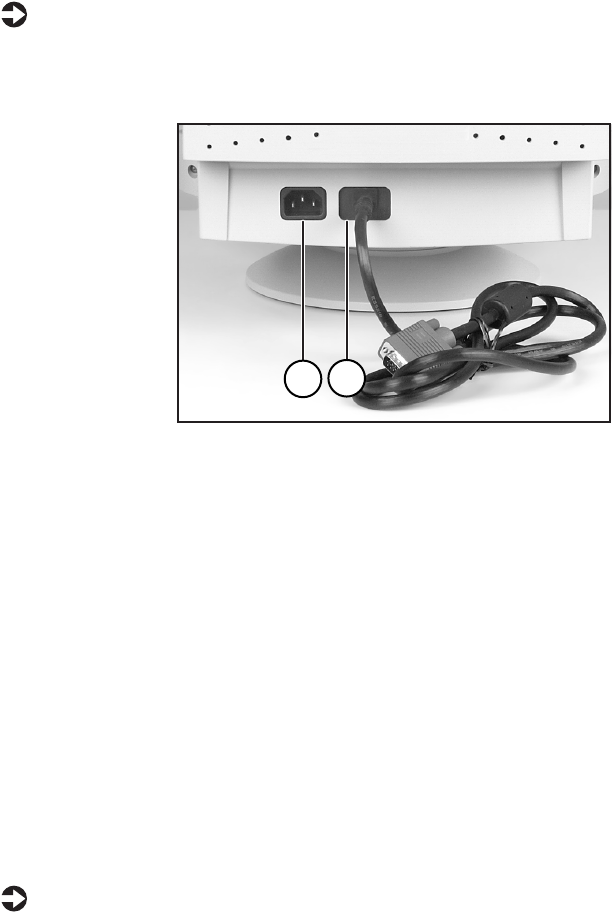
4 Using Your LE500 Monitor
To connect the power and video cables:
1Position the monitor and the computer so that you can easily get at the back panel
of each. Make sure all power cables can reach a properly grounded electrical outlet.
AAC power connector
BVideo cable (permanently connected)
2Connect the video cable to the matching blue video connector on the back of your
computer.
3Tighten the screws on the video cable connectors to keep them from coming loose.
Tightening the screws also prevents radio and TV interference.
4Connect the power cord that came with the monitor to the AC power connector at
the back of the monitor. To maintain FCC standards, only use the cord that came
with the monitor.
5Plug the other end of the power cord into a properly grounded electrical outlet.
Removing the base
To remove the base:
1Turn off the system, then disconnect the monitor’s video and power cables.
2Carefully set the monitor on its side with the bottom of the monitor facing you.
3Rotate the base so that you can easily get to the retaining latch on the bottom of the
monitor.
A
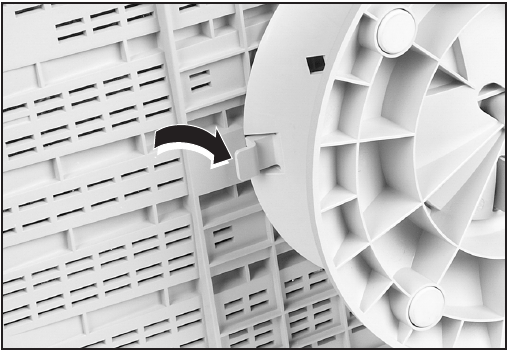
Setting up the monitor 5
4Press down on the retaining latch. While holding down the latch, slide the base toward
the back of the monitor.

6 Using Your LE500 Monitor
Starting the monitor
To start the monitor:
1Press the power button once. The power LED lights and the monitor demagnetizes
itself for about five seconds.
2Turn on the computer.
3Once the system is running, the power LED on the monitor should be green. If not,
check the connections. For troubleshooting information, see the “Troubleshooting”
section of this guide.
4Adjust the controls to get the best picture. Experiment with the display settings to
choose the ideal image size and position for you. See the “Adjusting display settings”
section in this guide for information about changing your display.
Caution Do not store tapes or diskettes next to the monitor because
the monitor generates a strong magnetic field during
startup. This field can erase or damage data stored on
magnetic tapes or diskettes.
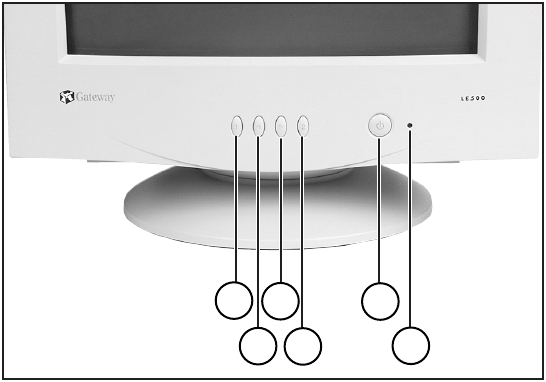
Adjusting display settings 7
Adjusting display settings
This monitor features an On Screen Display (OSD) that lets you adjust and save contrast,
brightness, and other visual settings for the display image.
AButton 1. Press to view the OSD.
BLeft arrow button. Press to move between the OSD options. After selecting
an option, use to adjust the setting.
CRight arrow button. Press to move between OSD options. After selecting
an option, use to adjust the setting.
DButton 2. Press to select an OSD option.
EPower button
FPower LED
The system saves any changes you make to the settings, even if you turn off the monitor.
AC
D
E
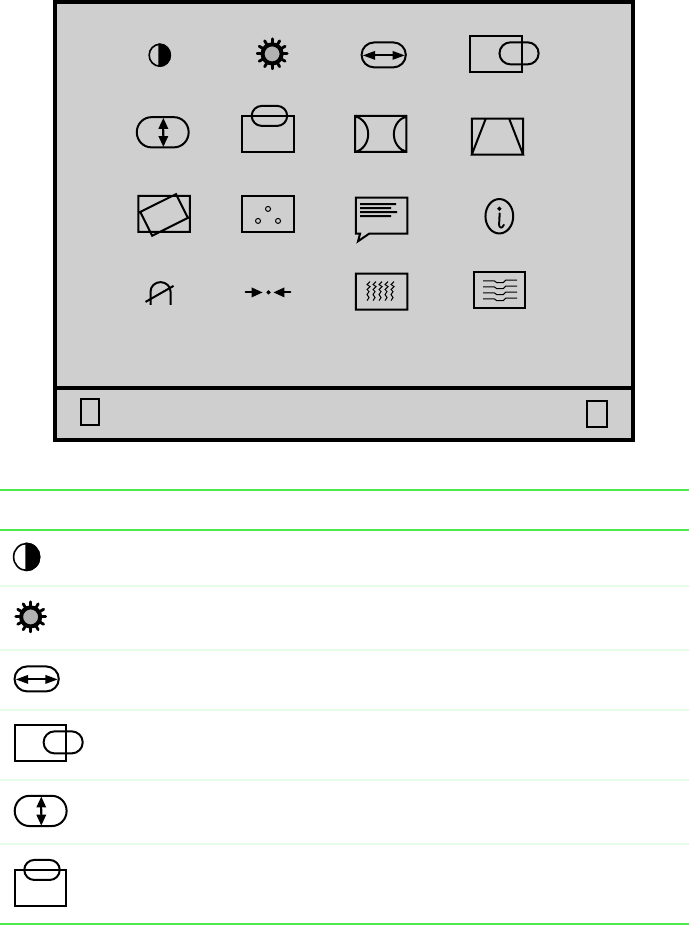
8 Using Your LE500 Monitor
OSD options
Icon Options
Contrast increases or decreases display image contrast.
Brightness increases or decreases display image brightness.
Horizontal Size increases or decreases the width of the display
image.
Horizontal Position moves the display image to the left or right side
of the screen.
Vertical Size increases or decreases the height of the display image.
Vertical Position moves the display image to the top or bottom of
the screen.
12
unction displayed here
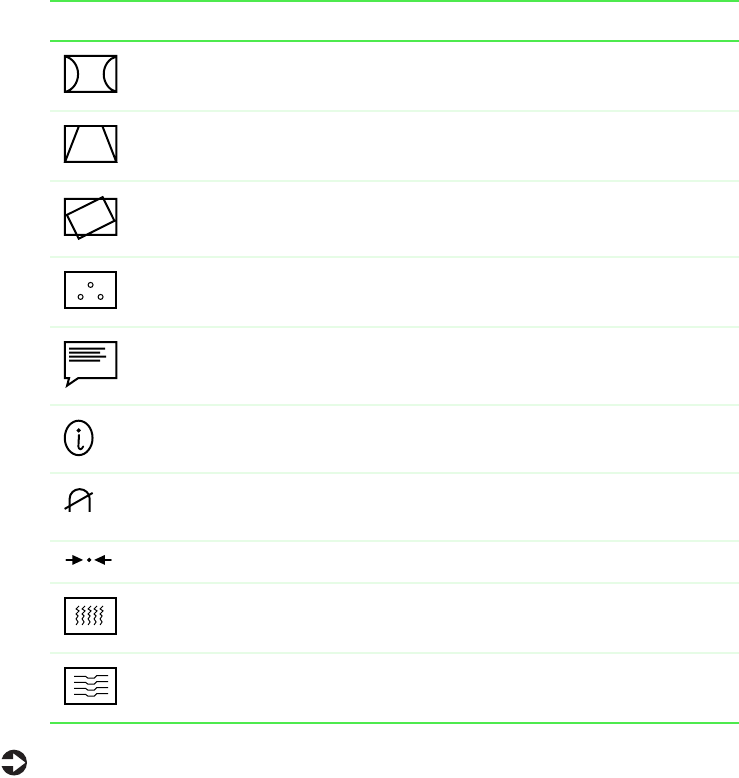
Adjusting display settings 9
To adjust the display settings:
1Press Button 1. The OSD menu opens.
2Use the arrow buttons to highlight an option. The name of the highlighted option
appears at the bottom of the menu.
3Press Button 2 to select the highlighted option, then use the arrows to adjust it. Some
options can only be enabled or disabled.
Press Button 1 to return to the menu and make more changes.
4When you have finished making all selections, press Button 1 to exit the OSD.
Pincushion curves the sides of the display image inward or outward.
Trapezoid increases or decreases the trapezoid
distortion of the display image.
Rotation rotates the display to the left or right.
Color opens the color menu.
Language changes the display language for the OSD control system.
Display Frequency displays the horizontal and vertical frequency
settings of your monitor.
Degauss removes magnetic discoloration from the display image.
Recall returns most options to the original factory default settings.
Horizontal Moire removes horizontal moire effects from image.
Vertical Moire removes vertical moire effects from image.
Icon Options

10 Using Your LE500 Monitor
Video modes
If you are playing a game or using a program that does not look right, you can select from
several preset modes that may improve the display. Refer to the documentation that came
with the game or program for suggested display modes. The preset video modes are:
If one of the preset modes does not fix the problem, you can make changes to the settings.
They will be stored so that you can recall them later.
For information about adjusting your monitor’s contrast and brightness, see the “Adjusting
Display Settings” section of this manual.
Display Modes (Resolution) Horizontal
Frequency
Vertical
Frequency
1 VESA 640 ×480 31.469 KHz 60 Hz
2 VESA 640 ×480 37.500 KHz 75 Hz
3 DOS 720 ×400 31.470 KHz 70 Hz
4 VESA 800 ×600 37.879 KHz 60 Hz
5 VESA 800 ×600 46.875 KHz 75 Hz
6 VESA 1024 ×768 48.363 KHz 60 Hz
7 VESA 1024 ×768 60.023 KHz 75 Hz

Power management 11
Power management
ENERGY STAR
As an ENERGY STAR® Partner, Gateway has determined that this product meets the
ENERGY STAR guidelines for energy efficiency.
This monitor complies with the EPA's International ENERGY STAR Program, which is
a program designed to have manufacturers of computer equipment build circuitry into their
products to reduce energy consumption during time of non-use.
Energy declaration
When connected to a computer that supports the VESA Display Power Management
Signaling (DPMS) Protocol, this monitor can conserve significant energy by reducing
power consumption during periods of non-use. When the computer goes into the energy
saving mode (Standby), the monitor goes into a suspended operating state and the power
LED light changes from a green color to an amber color.
After an extended period in the suspended mode, the monitor will then enter the Off mode
(different from total shut down). In the Off mode the Power LED will still show amber.
By following these conventions the power can be reduced to the following levels:
To “wake” the monitor when it is in Standby or Off mode, move your mouse or press any
keyboard key.
You can change the period of time after which the monitor enters these low power states
by accessing the power management options in the Control Panel.
VESA state LED
indicator
Power consumption
On Green
Standby Amber Less than 10 W
Off Amber Less than 5 W

12 Using Your LE500 Monitor
Maintenance
To keep your monitor in optimal working order:
nDo not block the ventilation holes.
nDo not expose the monitor to rain or use near water.
nKeep the monitor away from radiators or heat vents.
nKeep the monitor out of direct sunlight.
nKeep the monitor away from any equipment that generates a magnetic field.
nClean the monitor using a soft cloth lightly moistened with water. Wipe the cabinet,
glass panel, and controls.
Caution Do not use any type of abrasive pad or cleaner. You can
permanently scratch the glass panel.

Troubleshooting 13
Troubleshooting
If you have problems with your monitor, this troubleshooting section may help you identify
and fix them.
No picture
nMake sure the power cord is properly connected to both the back of the monitor and
the wall outlet.
nMake sure the video cable is securely connected to the back of the computer.
nMake sure the monitor power button is on.
nIf the power saving indicator is orange or blinking orange:
nMake sure that the computer is on.
nMove the mouse or press any key on the keyboard to bring the monitor out
of sleep mode.
nCheck the video connector and the end of the video cable for any pins that
might be bent or pushed in.
nMake sure that the video cable is not damaged.
nRestart the computer with the monitor turned on.
nPerform a monitor self-test by turning off your monitor and unplugging the video
cable from the back of the computer. Turn the monitor back on and wait for ten
seconds. If the monitor is functioning properly, a self-diagnostic screen appears.
Important Make sure that the monitor has warmed up for
approximately 30 minutes before making any judgments
about the picture quality.

14 Using Your LE500 Monitor
Picture is scrambled
If your picture is scrambled or does not look right, you can reset your monitor to its default
video mode and resolution settings. See the “Adjusting display settings” section of this
guide for more information.
To reset your monitor to its default settings:
1Start the system.
2Press CTRL.
3Select Safe mode. Windows starts in a “safe mode,” which means that most drivers
are not loaded.
4Click Start, then select Settings, then Control Panel. The Control Panel window
opens.
5Click/Double-click the Display icon. The Display Properties window opens.
6Click the Settings tab.
7Click Advanced. The Advanced Display Properties window opens.
8Click the Monitor tab.
9Click Change. The Select Device window opens.
10 Select Plug and Play monitor (VESA DDC) by following the on-screen instructions.
11 Restart Windows.
Display colors are wrong
nCheck the video connector and the end of the video cable for any pins that might
be bent or pushed in.
nMake sure the video cable is securely connected to the back of the computer.
nMake sure that the video cable is not damaged.
nRestart the system (leaving the monitor on).
Picture is fuzzy
Adjust the contrast and brightness controls to improve the display image. See the
“Adjusting display settings” section of this guide for more information.
Troubleshooting 15
Picture bounces, jitters, or has waves
Make sure that:
nNon-shielded speakers are not placed too close to the monitor.
nThe monitor is not positioned too close to another monitor, electric fan, fluorescent
light, metal shelf, or laser printer.
nIf none of these suggestions solves the problem, try plugging the monitor into another
outlet, preferably one on a different circuit.
Picture has shadows or “ghosts”
nRemove any extension cables or switchboxes.
nCheck the video connector and the end of the video cable for any pins that might
be bent or pushed in.
nMake sure the video cable is securely connected to the back of the monitor and to
the back of the computer.
nMake sure that the video cable is not damaged.
16 Using Your LE500 Monitor
Color is not uniform
Make sure the monitor warms up for at least 30 minutes before making a final judgment
about color uniformity.
Make sure that:
nNon-shielded speakers are not placed too close to the monitor.
nThe monitor is not positioned too close to another monitor, electric fan, fluorescent
light, metal shelf, or laser printer.
nYou demagnetize the screen using the degauss feature in the OSD.
Image is not sized or centered properly
Use the size and center controls to adjust the image. See the “Adjusting display settings”
section in this guide for information about the OSD control system.
Image cannot be adjusted full screen
Some video modes used by your monitor produce images that cannot be adjusted all the
way out to the bezel edge (the edge where the screen glass and monitor casing meet).
This condition does not indicate that the monitor is defective.
Specifications 17
Specifications
Specifications are subject to change without notice or obligation.
Many products for Gateway and its subsidiaries are custom engineered by our suppliers
to Gateway specifications and may vary with similarly marketed products.
CRT 15-inch diagonal (14 inches viewable),
anti-reflective/anti-glare, 90° deflection, 0.28 mm
dot pitch CRT
Maximum resolution 1280 ×1024
Display colors Unlimited
Scanning frequency Horizontal, 30-69 KHz (automatic)
Vertical, 50-120 Hz (automatic)
Power input AC 90 –264 V, 50/60 Hz, 2.0/1.0 A
Dimensions (with tilt/swivel stand) 14.6 ×15.5 15.8 inches (W ×H×D)
371 ×390.5×393.5 cm (W ×H×D)
Weight 31.0 lbs (14.0 Kg)
Certifications UL, CUL, DHHS, FCC Class B, and VCCI Class 2
Power management Meets ENERGY STAR requirements:
Suspend mode = <15 W
Active-off mode = <5 W
18 Using Your LE500 Monitor

19
2
Safety,
Regulatory, and
Legal Information
Important safety information
Your Gateway system is designed and tested to meet the latest standards for safety of information technology
equipment. However, to ensure safe use of this product, it is important that the safety instructions marked on the
product and in the documentation are followed.
Setting up your system
nRead and follow all instructions marked on the product and in the documentation before you operate your
system. Retain all safety and operating instructions for future use.
nDo not use this product near water or a heat source such as a radiator.
nSet up the system on a stable work surface.
nThe product should only be operated from the type of power source indicated on the rating label.
nIf your product has a voltage selector switch, make sure that the switch is in the proper position for your area.
The voltage selector switch is set at the factory to the correct voltage.
nOpenings in the monitor case are provided for ventilation. Do not block or cover these openings. Make sure
you provide adequate space, at least 6 inches (15 cm), around the system for ventilation when you set up your
work area. Never insert objects of any kind into the monitor ventilation openings.
nSome products are equipped with a three-wire power cord to make sure that the product is properly grounded
when in use. The plug on this cord will only fit into a grounding-type outlet. This is a safety feature. If you are
unable to insert the plug into an outlet, contact an electrician to install the appropriate outlet.
nIf you use an extension cord with this system, make sure that the total ampere rating on the products plugged
into the extension cord does not exceed the extension cord ampere rating.
nIf your system is fitted with a TV Tuner, cable, or satellite receiver card, make sure that the antenna or cable
system is electrically grounded to provide some protection against voltage surges and buildup of static charges.
Warning Always follow these instructions to help guard against
personal injury and damage to your Gateway system.
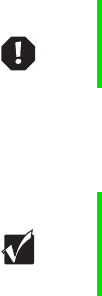
20 Safety, Regulatory, and Legal Information
Care during use
nDo not walk on the power cord or allow anything to rest on it.
nDo not spill anything on the system. The best way to avoid spills is to avoid eating and drinking near your
system.
nWhen the monitor is turned off, a small amount of electrical current still flows through the monitor. To avoid
electrical shock, always unplug all power cables and modem cables from the wall outlets before cleaning the
system.
nUnplug the system from the wall outlet and refer servicing to qualified personnel if:
nThe power cord or plug is damaged.
nLiquid has been spilled into the system.
nThe system does not operate properly when the operating instructions are followed.
nThe system was dropped or the cabinet is damaged.
nThe system performance changes.
Replacement parts and accessories
Use only replacement parts and accessories recommended by Gateway.
Warning To prevent electric shock, never remove the cover. No user
serviceable parts inside. Refer servicing to qualified
service personnel.
Important Do not use Gateway products in areas classified as
hazardous locations. Such areas include patient care
areas of medical and dental facilities, oxygen-laden
environments, or industrial facilities.

21
Regulatory compliance statements
United States users
FCC Part 15
This device has been tested and found to comply with the limits for a Class B digital device, pursuant to Part 15
of the FCC rules. These limits are designed to provide reasonable protection against harmful interference in a
residential installation. This equipment generates, uses, and can radiate radio frequency energy and, if not
installed and used in accordance with the instructions, may cause harmful interference to radio or television
reception. However, there is no guarantee that interference will not occur in a particular installation. If this
equipment does cause interference to radio and television reception, which can be determined by turning the
equipment off and on, the user is encouraged to try to correct the interference by one or more of the following
measures:
nReorient or relocate the receiving antenna
nIncrease the separation between the equipment and receiver
nConnect the equipment into an outlet on a circuit different from that to which the receiver is connected
nConsult the dealer or an experienced radio/TV technician for help.
Compliance Accessories: The accessories associated with this equipment are: shielded video cable. These
accessories are required to be used in order to ensure compliance with FCC rules.
Canadian users
ICES-003
This digital apparatus does not exceed the Class B limits for radio noise emissions from digital apparatus as set
out in the radio interference regulations of Industry Canada.
Le présent appareil numérique n’émet pas de bruits radioélectriques dépassant les limites applicables aux
appareils numériques de Classe B prescrites dans le règlement sur le brouillage radioélectrique édicté par
Industrie Canada.
Caution Changes or modifications not expressly approved by
Gateway could void the FCC compliance and negate your
authority to operate the product.

22 Safety, Regulatory, and Legal Information
European users
European directives
This Information Technology Equipment has been tested and found to comply with the following European
directives:
nEMC Directive 89/336/EEC amending directive 92/31/EEC & 93/68/EEC as per
- EN 50081-1:1992 according to
EN 55022:1994 Class B
EN 61000-3-2:1995 or EN 60555-2:1987
EN 61000-3-3:1995 or EN 60555-3:1987
- EN 50082-1:1992 according to
EN 61000-4-2:1995 or IEC 801-2:1984
EN 61000-4-3:1996 or IEC 801-3:1984
EN 61000-4-4:1995 or IEC 801-4:1988
nLow Voltage Directive (Safety) 73/23/EEC as per EN 60950:1992(A1/A2/A3/A4/A11)
Japanese users
VCCI statement
This equipment is in the Class B category (Information Technology Equipment to be used in a residential area or
an adjacent area thereto) and conforms to the standards set by the Voluntary Control Council for Interference by
Information Technology Equipment aimed at preventing radio interference in such residential areas. When used
near a radio or TV receiver, it may become the cause of radio interference. Read instructions for correct handling.
Australia and New Zealand users
EMI statement
This device has been tested and found to comply with the limits for a Class B digital device, pursuant to the
Australian/New Zealand standard AS/NZS 3548 set out by the Australian Communications Authority and Radio
Spectrum Management Agency.

23
EPA ENERGY STAR
As an ENERGY STAR® Partner, Gateway has determined that this product meets
the ENERGY STAR guidelines for energy efficiency when used with a computer
equipped with a Display Power Management System.
24 Safety, Regulatory, and Legal Information
Notices
Copyright © 2000 Gateway, Inc.
All Rights Reserved
4545 Town Centre Court
San Diego, CA 92121 USA
All Rights Reserved
This publication is protected by copyright and all rights are reserved. No part of it may be reproduced or
transmitted by any means or in any form, without prior consent in writing from Gateway.
The information in this manual has been carefully checked and is believed to be accurate. However, changes are
made periodically. These changes are incorporated in newer publication editions. Gateway may improve and/or
change products described in this publication at any time. Due to continuing system improvements, Gateway is
not responsible for inaccurate information which may appear in this manual. For the latest product updates,
consult the Gateway Web site at www.gateway.com. In no event will Gateway be liable for direct, indirect,
special, exemplary, incidental, or consequential damages resulting from any defect or omission in this manual,
even if advised of the possibility of such damages.
In the interest of continued product development, Gateway reserves the right to make improvements in this
manual and the products it describes at any time, without notices or obligation.
Trademark Acknowledgments
AnyKey, black-and-white spot design, CrystalScan, Destination, EZ Pad, EZ Point, Field Mouse, Solo, TelePath,
Vivitron, stylized “G” design, and “You’ve got a friend in the business” slogan are registered trademarks and
GATEWAY, Gateway Profile, Gateway Solo, Gateway Astro, green stylized GATEWAY, green stylized Gateway
logo, and the black-and-white spotted box logo are trademarks of Gateway, Inc. Intel, Intel Inside logo, and
Pentium are registered trademarks and MMX is a trademark of Intel Corporation. Microsoft, MS, MS-DOS, and
Windows are trademarks or registered trademarks of Microsoft Corporation. All other product names mentioned
herein are used for identification purposes only, and may be the trademarks or registered trademarks of their
respective companies.